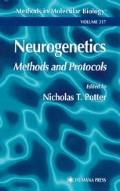Abstract
Huntington’s Disease (HD) is an autosomal dominant neurodegenerative disorder with an incidence of 1/10,000. The disease is characterized by involuntary choreic movements, psychiatric disorders, dementia, and death within 15-20 years. When the HD gene was cloned in 1993, it was discovered that the causative mutation was an expansion of a CAG trinucleotide repeat (1) and to date HD is one of 14 trinucleotide repeat diseases (2). The expanded CAG sequence in exon 1 of the HD gene, IT15, likewise encodes an expanded polyglutamine tract resulting in an aberrant huntingtin protein, which leads to neuronal specific death predominantly within the neostratum (3). Huntington is widely expressed in both the brain and nonneural tissues (4) and interestingly, N-terminal fragments of huntingtin, containing the elongated polyglutamine residues form aggregates, and can be visualized as cytoplasmic and nuclear inclusions (5).
Access this chapter
Tax calculation will be finalised at checkout
Purchases are for personal use only
References
Huntington’s Disease Collaborative Research Group (1993) A novel gene containing a trinucleotide repeat that is expanded and unstable on Huntington’s disease chromosomes. Cell 72, 971–983.
Cummings, C. J. and Zoghbi, H. Y. (2000) Fourteen and counting: unraveling trinucleotide repeat diseases. Hum. Mol. Gene. 9, 909–916.
Reiner, A., Albin R. L., Anderson, K. D., et al. (1988) Differential loss of striatal projection neurons in Huntington disease. Proc. Natl. Acad. Sci. USA 85, 5733–5737.
Davies, S. W., Turmaine, M., Cozens, B. A., et al. (1997) Formation of neuronal intranuclear inclusions underlies the neurological dysfunction in mice transgenic for the HD mutation. Cell 90, 537–548.
Strong, T. V., Tagle, D. A., Valdes, J. M., et al. (1993) Widespread expression of the human and rat Huntington’s disease gene in brain and nonneural tissues. Nat. Gene. 5, 259–265.
Meissen, G. J., Myers, R. H., Mastromauro, C. A., et al. (1988) Predictive testing for Huntington’s disease with use of a linked DNA marker. N. Engl. J. Med. 318, 535–542.
Duyao, M., Ambrose, C., Myers, R., et al. (1993) Trinucleotide repeat length instability and age of onset in Huntington’s disease. Nat. Gene. 4, 387–392.
McNeil, S. M., Novelletto, A., Srinidhi, J., et al. (1997) Reduced penetrance of the Huntington’s disease mutation. Hum. Mol. Gene. 6, 775–779.
Rubinsztein, D. C., Leggo, J., Coles, R., et al. (1996) Phenotypic characterization of individuals with 30-40 CAG repeats in the Huntington Disease (HD) gene reveals HD cases with 36 repeats and apparently normal elderly individuals with 36-39 repeats. Am. J. Hum. Gene. 59, 16–22.
Goldberg, Y. P., McMurray, C. T., Zeisler, J., et al. (1995) Increased instability of intermediate alleles in families with sporadic Huntington disease compared to similar sized intermediate alleles in the general population. Hum. Mol. Gene. 4, 1911–1918.
Warner, J. P., Barron, L. H. Brock, D. J. H., et al. (1993) A new polymerase chain reaction (PCR) assay for the trinucleotide repeat that is unstable and expanded on Huntington’s disease chromosomes. Mol. Cell. Probes 7, 235–239.
(1994) Guidelines for the molecular genetics predictive test in Huntington’s disease. International Huntington Association (IHA) and the World Federation of Neurology (WFN) Research Group on Huntington’s Chorea. Neurology 44, 1533–1536.
Author information
Authors and Affiliations
Editor information
Editors and Affiliations
Rights and permissions
Copyright information
© 2003 Humana Press Inc.
About this protocol
Cite this protocol
Vnencak-Jones, C.L. (2003). Fluorescence PCR and GeneScan® Analysis for the Detection of CAG Repeat Expansions Associated with Huntington’s Disease. In: Potter, N.T. (eds) Neurogenetics. Methods in Molecular Biology™, vol 217. Springer, Totowa, NJ. https://doi.org/10.1385/1-59259-330-5:101
Download citation
DOI: https://doi.org/10.1385/1-59259-330-5:101
Publisher Name: Springer, Totowa, NJ
Print ISBN: 978-0-89603-990-2
Online ISBN: 978-1-59259-330-9
eBook Packages: Springer Protocols

